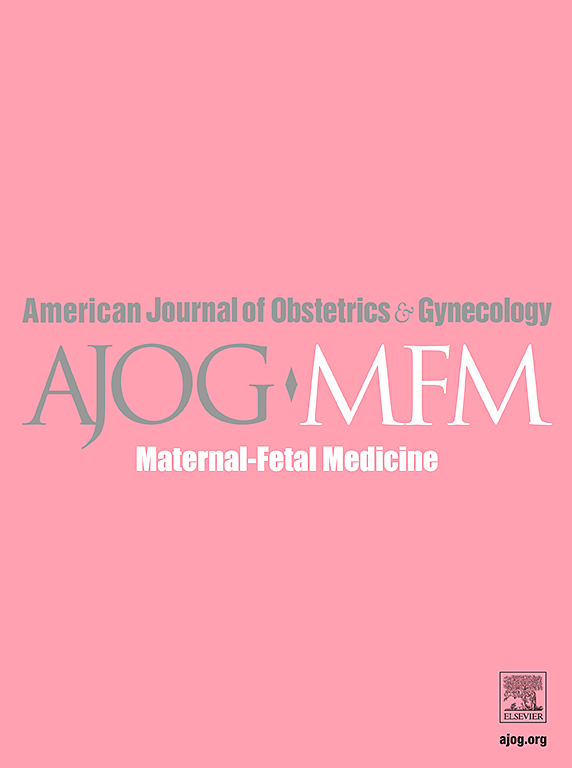明显孤立的多胎妊娠中的基因组异常及确诊胎儿表型的作用:系统回顾和荟萃分析。
IF 3.8
2区 医学
Q1 OBSTETRICS & GYNECOLOGY
American Journal of Obstetrics & Gynecology Mfm
Pub Date : 2024-10-01
DOI:10.1016/j.ajogmf.2024.101469
引用次数: 0
摘要
目的本系统综述和荟萃分析旨在评估在明显孤立的水肿妊娠中发现的基因组异常率,并探讨已证实的胎儿表型的作用:研究资格标准:本荟萃分析纳入了 2000 年后发表的、以欧洲语言撰写的观察性研究,这些研究报告了产前诊断为孤立性多羊水综合症的并发妊娠的基因组结果:主要结果是孤立性多胎妊娠并发症新生儿产前或产后诊断出的基因组异常发生率,基因组异常定义为染色体数量或结构异常或单基因综合征。其他结果包括染色体异常的发生率,包括染色体数目和结构畸变(通过核型/染色体微阵列[CMA]检测)、单基因异常(通过下一代测序[NGS]或核型/CMA结果正常后的临床基因检查检测)、一般遗传综合征(临床诊断有或无基因确认)以及产后检测到的结构异常。对每种结果都计算了汇总比例:荟萃分析纳入了 12 项研究(2561 例合并孤立性水肿的妊娠)。明显孤立性多羊水综合征胎儿(12 项研究,2634 个胎儿)基因组异常的汇总患病率为 4.5%(95%CI 2.6-7.6)。染色體異常的合併流行率(11 項研究,2427 名胎兒)為 2.1%(95%CI 1.1-3.7)。产后发现的主要结构缺陷(9 项研究,1731 个胎儿)的比例为 2.9%(95%CI 1.5-5.4);在这一特定亚组(4 项研究,14 个胎儿)中,基因组异常的汇总患病率为 29.8%(95%CI 11.3-58.6)。元回归分析表明,基因组异常率与水肿的严重程度呈正相关。此外,在两项使用 NGS 进行基因组诊断的研究中,单基因异常的汇总率为 5.6% (95%CI 2-5; I2 =58%):这项荟萃分析表明,在明显孤立的多胎妊娠中,基因组异常率为 4.5%;其中约一半为染色体异常,另一半为非染色体基因组异常。从临床角度看,即使是表面上孤立的多胎妊娠,也应考虑 CMA 和可能的 NGS;这对胎儿表型不完整的病例可能更为重要。使用 NGS 和解决成本效益问题的进一步研究将对这些建议进行微调。本文章由计算机程序翻译,如有差异,请以英文原文为准。
Genomic abnormalities in apparently isolated polyhydramnios and the role of confirmed fetal phenotype: a systematic review and meta-analysis
OBJECTIVE
The aim of this systematic review and meta-analysis was to assess the rate of genomic abnormalities detected in pregnancies with apparently isolated hydramnios and to explore the role of confirmed fetal phenotype.
DATA SOURCES
The PubMed, Cochrane Library, Google Scholar, and Scopus databases were searched up to May 4, 2024.
STUDY ELIGIBILITY CRITERIA
Observational studies that were published after the year 2000, written in a European language, and that reported the genomic outcomes of pregnancies complicated by prenatally diagnosed isolated polyhydramnios were included in this meta-analysis.
METHODS
The main outcome was the incidence of genomic abnormalities, defined as chromosomal numerical or structural anomalies or monogenic syndromes, that were diagnosed prenatally or postnatally in neonates from pregnancies complicated by isolated polyhydramnios. Additional outcomes included the incidence of chromosomal abnormalities, including both numerical and structural aberrations of the chromosomes (detected by karyotype or chromosomal microarray), monogenic abnormalities (detected by next-generation sequencing or clinical genetic examination after the result of a normal karyotype or chromosomal microarray), genetic syndromes in general (diagnosed clinically with or without genetic confirmation), and structural abnormalities detected postnatally. Pooled proportions were calculated for each outcome.
RESULTS
A total of 12 studies (2561 pregnancies complicated by isolated hydramnios) were included in the meta-analysis. The pooled prevalence of genomic anomalies in fetuses with apparently isolated polyhydramnios (12 studies, 2634 fetuses) was 4.5% (95% confidence interval, 2.6–7.6). The pooled prevalence of chromosomal abnormalities (11 studies, 2427 fetuses) was 2.1% (95% confidence interval, 1.1–3.7). The proportion of major structural defects detected postnatally (9 studies, 1731 fetuses) was 2.9% (95% confidence interval, 1.5–5.4); in this particular subgroup (4 studies, 14 fetuses), the pooled prevalence of genomic anomalies was 29.8% (95% confidence interval, 11.3–58.6). A meta-regression analysis indicated that the rate of genomic anomalies was positively associated with the severity of hydramnios. In addition, the pooled rate of monogenic anomalies was 5.6% (95% confidence interval, 2–5; I2=58%) in the 2 studies that used next-generation sequencing for genomic diagnosis.
CONCLUSION
This meta-analysis showed that the rate of genomic anomalies in apparently isolated polyhydramnios is 4.5%; approximately half of them are chromosomal abnormalities and the other half are nonchromosomal genomic anomalies. From a clinical standpoint, chromosomal microarray analysis and possibly next-generation sequencing could be considered even in cases of apparently isolated polyhydramnios; this may be even more important in cases with incomplete fetal phenotype. Further studies using next-generation sequencing and addressing cost-effectiveness issues would fine-tune such recommendations.
求助全文
通过发布文献求助,成功后即可免费获取论文全文。
去求助
来源期刊

American Journal of Obstetrics & Gynecology Mfm
Medicine-Medicine (all)
CiteScore
7.40
自引率
3.20%
发文量
254
审稿时长
40 days
期刊介绍:
The American Journal of Obstetrics and Gynecology (AJOG) is a highly esteemed publication with two companion titles. One of these is the American Journal of Obstetrics and Gynecology Maternal-Fetal Medicine (AJOG MFM), which is dedicated to the latest research in the field of maternal-fetal medicine, specifically concerning high-risk pregnancies. The journal encompasses a wide range of topics, including:
Maternal Complications: It addresses significant studies that have the potential to change clinical practice regarding complications faced by pregnant women.
Fetal Complications: The journal covers prenatal diagnosis, ultrasound, and genetic issues related to the fetus, providing insights into the management and care of fetal health.
Prenatal Care: It discusses the best practices in prenatal care to ensure the health and well-being of both the mother and the unborn child.
Intrapartum Care: It provides guidance on the care provided during the childbirth process, which is critical for the safety of both mother and baby.
Postpartum Issues: The journal also tackles issues that arise after childbirth, focusing on the postpartum period and its implications for maternal health. AJOG MFM serves as a reliable forum for peer-reviewed research, with a preference for randomized trials and meta-analyses. The goal is to equip researchers and clinicians with the most current information and evidence-based strategies to effectively manage high-risk pregnancies and to provide the best possible care for mothers and their unborn children.
 求助内容:
求助内容: 应助结果提醒方式:
应助结果提醒方式:


